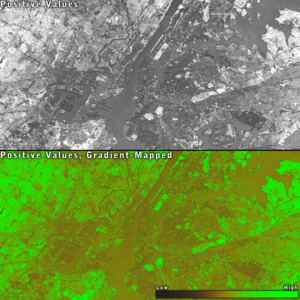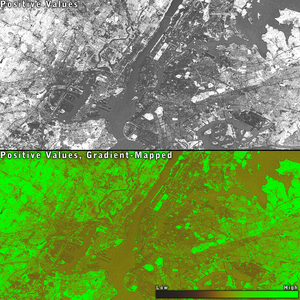slavi
|
Contents: Description, Arguments, Usage, Examples, Images, Related Functions, Source Supported Under Version: > 1.00
Description Generates a Specific Leaf Area Vegetation Index map
Arguments and Return Values Arguments: 1- or 2-dimensional greyscale images representing mid-infrared (LandSat band 5 (1500nm - 1750nm), or band 7 (2090nm - 2350nm)), near-infrared, and red, and blue spectral bands (all three are required) Return Value: A float greyscale image
Usage Syntax: slavi(mir, nir, red) This function is part of the larger class of vegetation-index methods used in satellite image-processing. See ndi or this discussion of related functions for more detailed information. ARVI is of the subtype which will return both positive and negative values. Positive values generally indicate the presence of vegetation (with greater values indicating healthier vegetation). Negative values generally indicate a lack of vegetation (water, rock, soil, etc.). The formula used is: SLAVI = NIR / (Red + MIR) This formula was obtained from "Landsat Image Processing" (James S. Aber, 2009). The SLAVI calculation is referenced in numerous locations, but the specifics of whether LandSat band 5 or band 7 should be used is not as well-documented. Aber specifically references a paper by "Lymburner et al" from 2000 which indicates that band 7 should be used, but other sources simply indicate "MIR" or "SWIR". Anecdotally, band 7 seems to provide slightly higher-contrast results.
Examples dv> mir2 2000x1000x1 array of float, bsq format [8,000,000 bytes] dv> nir 2000x1000x1 array of float, bsq format [8,000,000 bytes] dv> r 2000x1000x1 array of float, bsq format [8,000,000 bytes] dv> result = slavi(mir2, nir, r) Generating a Specific Leaf Area Vegetation Index image. 2000x1000x1 array of float, bsq format [8,000,000 bytes] dv> max(result) 93.00000000 dv> min(result) 0.0000000000
|
DavinciWiki Mini-Nav Bar Contents
Contact Developers
All other topics
Recent Library Changes Created On: 07-16-2012 |


